 Royal Navy (1930-34)
Royal Navy (1930-34)C class: HMS Comet, Crusader, Cygnet, Crescent (To Canada)
C class Leader: HMS Kempenfelt
D-class: HMS Dainty, Daring, Decoy, Defender, Delight, Diamond, Diana, Duchess
D-class leader: HMS Duncan
WW2 British Destroyers:
V class | W class | W mod class | Shakespeare class (1917) | Scott class (1818) | A/B class (1926) | C/D class (1931) | E/F class (1933) | G/H class (1935) | I class (1936) | Tribal class (1937) | J/K/N class (1938) | L/M class (1940) | Hunt class DE (1939) | O/P class (1942) | Q/R class (1942) | S/T/U/V/W class (1942) | Z/ca class (1943) | Ch/Co/Cr class (1944) | Battle class (1945) | Weapon class (1945)Hunt Type I class DE (1939) | Hunt Type I class DE (1939) | Hunt Type I class DE (1939) | Hunt Type I class DE (1939) | Captain class DE (1941)
The C and D class were 14 destroyers built for the Royal Navy and a repeat of the 1926 A-B designs, albeit enlarged and having a new 3-in AA gun. The C class however was halved as an ecnoomical measure and for political reasons and was later transferred to Canada, so four plus the flotilla leader, HMS Kempenfelt, ordered under the 1929–1930 Programme. The D class were a strict repeat of the C class with an asdic and better ASW armament. They were completed under the 1930–1931 Programme as a full flotilla plus leader, HMS Duncan. Two of these were also transferred to Canada. They were very active in WW2, taking part in the bulk of engagements between Norway, the north sea, Atlantic, Mediterranean, Indian Ocean and beyond, Just four survived WW2.
Development of a follow-up class
The A and B class destroyers were the first interwar vessels destined to replace prewar destroyers as the V-W and flotilla leaders were destined to be kept in service for many more years. Genesis started already when the RN launched a prospect by November 1923. The admiralty request wanted destroyer to come up with a solid design incorporating all WWI lessons. Thornycroof answered with HMS Amazon and Yarrow with HMS Embuscade. Both had pros and cons but eventually the admiralty settled on the Thornycroft design (launched 1926) for its admiralty standard, while testing engine configurations. The final “product”, the “A” class was authorized in 1926 and orders were placed to various yards. The Acasta class from its lead ship was innovative at many levels and derived from the 1917-18 Scotts and Skakespear class flotilla leaders, toned down to become standards.
To the HMS Acasta, Achates, Active, Antelope, Anthony, Ardent, Arrow, Acheron and Canadian HMCS Saguenay, Skeena were added a leader, HMS Codrington, derived from the class but much costier, and the B class, very close (HMS Basilisk, Beagle, Blanche, Boadicea, Boreas, Brazen, Brilliant, Bulldog, leader HMS Keith). Keith was a “stock” vessel used as such with little modifications in the attmpt of making a cheaper leader. The last B class were completed in 1931.
Already plans for a follow-up class were planned in 1928. The new ships were based on the preceding B class, but as always the admirakty wanted to improve range, the remaining point of concerns for destroyers at large. Speed and armament were statisfactory. Thus, HMS Comet and Crusader, the two lead ship which plans were prepared at the Royal Navy Yard of Portmouth (so a true admiralty design) were enlarged. The idea was to increase endurance by having large fuel tanks. But also to give extra buoyancy and stability in order to include a QF 3-inch 20 cwt anti-aircraft gun, judged more effcient than the traditional 2-pdr pompom.
Like the A-B, the C class also repeated the same director-control tower but the design was unique in that there was for the first time a “split bridge”: The compass platform and wheelhouse were separated from the chartroom and director tower. This was an unusual layout, it after completions and trials, it was not repeated. The Admiralty policy alternated mine anbd ASW vessels, and included the provision of two ships with the Two-Speed Destroyer Sweep (TSDS), a proven WW1 minesweeping gear, or ASDIC (sonar) capability depending on the flotillas. The C class was designed to carry the TSDS but had still six depth charges.
Eventually, as in previous years, it was originally intended to have a full flotilla of eight destroyers smel letter destroyers led by an extra flotilla leader as a modified 8th unit. They were to be ordered the same year. However eventually plans were changed and the class was halved, with only four ships and leader being ordered under the 1929–1930 Programme. The C class sacrifice its strenght when presented both as an economy measure and disarmament gesture under the new Labour government of Ramsay MacDonald. However the next flotilla based on the D class under the 1930–1931 Programme was fullly completed.
The D class were repeats of the C class in all but names, but in their case the TSDS was replaced by 30 depth charges and an ASDIC, making them specialized ASW vessels. In this post the two will be seen starting with the leaders, and the careers of all fourteen destroyers.
Design of the class
Hull and general design

Greenwhich museum plan, HMS Dainty from Fairfield Shipbuilding & Engineering Co Ltd src
These ships were enlarged as said above mainly to procure larger fuel tanks and increase stability to install a QF 3-inch 20 cwt anti-aircraft gun. The class kept the director-control tower initially made for the A/B class, but much improved. They had notably a split bridge with compass platform and wheelhouse separated from the chartroom and director tower as said above, but that was not a success. Like the previous classes also, the C and D were split between the “minesweepers”” and the “sub-hunters”, ie. those having the Two-Speed Destroyer Sweep (TSDS) minesweeping gear and those having the ASDIC/sonar set and extra depht charge racks. The C class only had six depth charges, the D class 30.
But overall they repeated the previous design in the tinest details, which simplified construction across yards. They displaced more, at 1,375 long tons (1,397 t) in standard load, 1,865 long tons (1,895 t) at deep load for an overall length of 329 feet (100.3 m) and a beam of 33 feet (10.1 m) for a draught of 12 feet 6 inches (3.8 m) aft. To compare the A/B displaced 1,352 tons standard so an increase of 22 tons, for an increase in lenght from 311 ft 9 in (95.02 m) or 48 ft (5.4 meters), and in beam of 2 ft (from 31 ft 6 in/9.60 m) or 60 cm. Draught and buoyancy were also greater, from 9 ft 6 in (2.90 m) so 2.9 feet (90 cm) which was probably the greater change. Their complement was 145 officers and ratings, compared to 138 on the A/B class as well, notably due to the extra single 3-in AA gun instead. The leaders had more staff (see below).
The overall design was however similar in appearance still, with an upper deck showing a well rounded prow with substantial flare, limited sloped, limited slanted bow, and almost straight hull ending with a rounded bow with an elliptic curve starting aft amidship around number two funnel. The greated beam was reached around the main AA gun bandtsand between funnel, and from there the lines went forward in almost straight lines to the bow at the waterline. The counterkeels went from the bridge to the aft TT bank. The rudder still had the same trapezoidal shape and the upward stern keel started at the height of “B” mount.
Seen from profile, the silhouette was very much like the former one, with a superstructure forward and aft supporting superfiring AB, CD gun mounts, with deflectors on each upper position to protect gun crews on deck. The bridge had still the same square shape, with an enclosed level and open upper bridge with windows but no framing. The fire control turret and telemeter were behind. Two masts, raked the same way as the two equal funnels, the forward one slightly taller, and the foremast taller than the aft mainmast. The foremast carried a spotting post. The bridge’s wings were shorter than the deck’s width and the bridge block overhanged on the lower deck. Three service boats were carried, a whaler, a cutter and a yawl under davits. Life rafts were also carried in complement.
Powerplant
These ships were powered by Parsons geared steam turbines on two shafts, two identical propellers than the previous class. These turbines were fed by three Admiralty 3-drum water-tube boilers installed in their own rooms one after the other amidships, operating at a pressure of 300 psi (2,068 kPa; 21 kgf/cm2), temperature of 600 °F (316 °C). They developed a total of 36,000 shaft horsepower (27,000 kW). This was more than the A/B class’ 34,000 shp (25,000 kW) as performances increased between both generations. This was sufficient for a maximum speed of 36 knots (67 km/h; 41 mph), even better than the 35 knots of the A/B class. These destroyers also carried a maximum of 473 long tons (481 t) of fuel oil for a range of 5,500 nautical miles (10,200 km; 6,300 mi) at 15 knots (28 km/h; 17 mph). This was in contrast to the A/B’s 380t and 4,800 nmi (8,900 km; 5,500 mi) at 15 knots (28 km/h; 17 mph).
Armament
All C/D class vessels had the same four 45-calibre 4.7-inch Mk IX guns, all single mounts superfiring fore and aft in ‘A’, ‘B’, ‘X’, and ‘Y’ positions from the bow. Anti-aircraft (AA) defence for the first time was entrusted to a single QF 3-inch 20 cwt AA gun installed on a bandstand between the funnels. The C-class ships however had the same two 40-millimetre (1.6 in) QF 2-pounder Mk II AA guns as the A/B classes, but mounted on the aft end of the forecastle.
The D-class destroyers from the start had been planned to carry the enw QF 0.5-inch (12.7 mm) Mk III Vickers quad tandem machine gun, located on the bridge wings, but they were not available when completing, so 2-pounder guns subsitituted and kept for a while on HMS Daring, Diana, Diamond and Defender. The 3-inch AA gun was removed as obsolete in 1936–37, the 2-pounders replaced them between funnels on new platforms. No changes for torpedoes and the ASW suite diverged as well as seen above.
BL 4.7 inches/45 Mark IX
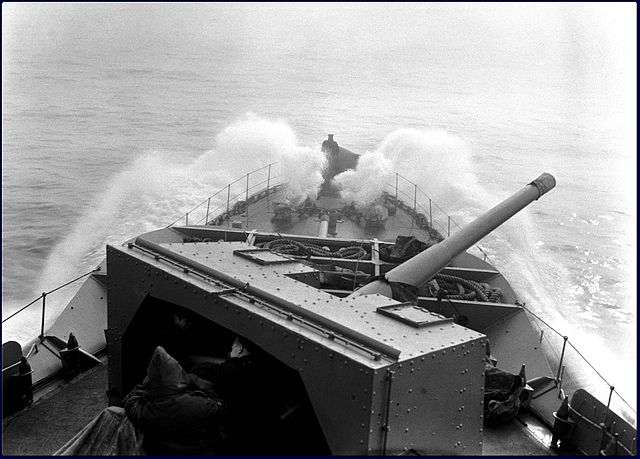
Produced from 1928, just as these classes were launched, the QF 4.7-inch Mk IX remained in service until 1970 and was used or exported to the RCN, RAN, Royal Hellenic Navy, Royal Netherlands Navy, Polish Navy, Royal Norwegian Navy, Turkish Navy, Dominican Navy, Argentine Navy, and Brazilian Navy with 742 Mk IX produced and 372 Mk XII of an improved design. They were installed on CP Mk.VI** mountings, max elevation 30°.
This was the ubiquitous ordnance in the Royal Navy and Commonwealth destroyers.
The main guns were controlled by the Admiralty Fire Control Clock Mk I which data came from the director and rangefinder. They were aimed solely by eye to deal with surface targets only.
Specifications Mark IX
Mass: 2.963–2.984 long tons (3,011–3,032 kg)
Length: 220.62 in (5.60 m) Barrel 212.58 in (5.40 m) L/45
Shell: Separate loading cased charge, 50 pds (22.7 kg) SAP/HE
Breech: Semi-automatic horizontal sliding-block, Hydro-pneumatic recoil
Perfs: 15 rounds per minute at 2,650 ft/s (810 m/s) to 16,970 yards (15,520 m) at 40°
3-in/45 QF 20 cwt QF Mk I-IV
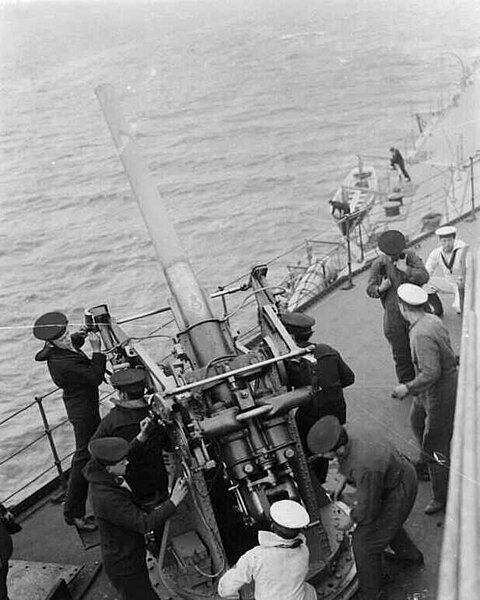
This was the great novelty of the design. It was believed at the time, back in 1926, that Aircraft speed made this piece of ordnance relevant, especially against large plane. Accuracy was not an issue, range was, and shrapnel. In 1937 however technology caught up and the concept was now irrelevant, they were removed and the two “pompom” installed in their place.
Specs: 2,240 lb (1,020 kg), gun and breech, Barrel 11 ft 4 in (3.45 m) (45 cal), 11 ft 9 in (3.58 m) oa
Crew: 11, Shell: Fixed QF HE 76.2 × 420 mm R 16 lb (7.3 kg), Semi-automatic sliding-block breech.
Elevation 90°, traverse 360°, 16–18 rpm, mv 2,500 ft/s (760 m/s), 12.5 lb (5.7 kg) shell, eff. range 16,000 ft (4,900 m)
2-pdr/39 Pompom QF Mk II
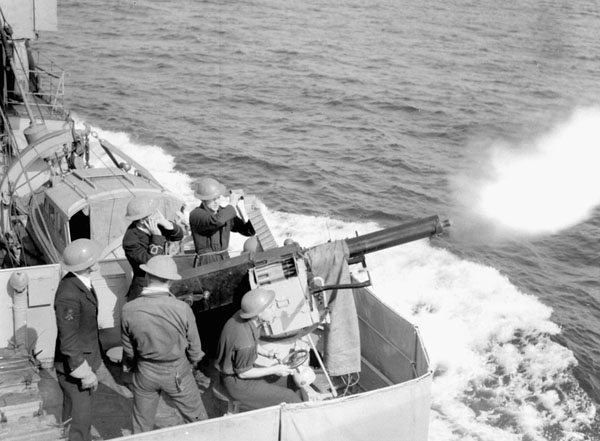
Specs:
Shell: 2 lb. (980 g) or 1.8 lb. (820 g) HV
Performances: 115 rpm fully automatic at 2,040 ft/s (622 m/s) or 2400 ft/s (732 m/s) for HV
Effective Range: 3,800 yards (3,475 m) or 5,000 yards (4,572 m) HV, Ceiling HV: 13,300 feet (3,960 m)
QF 0.5-inch Vickers Mk III
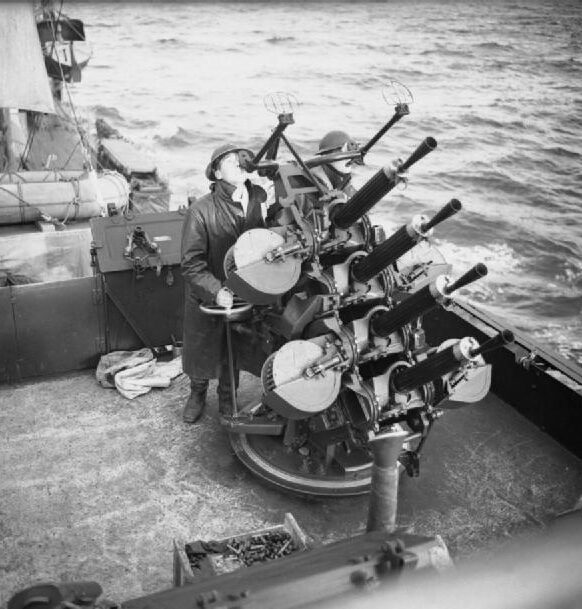
Two quad mounts. The Mark III was a navalized land version in mountings of four tandem guns here, installed on the wings from 1931. This mount proved insufficiently powerful at short-range but from 1940-41 they were replaced on a per-mount basis by Oerlikon 20 mm cannon. This mount used a 200-round magazine per barrel wrapping the ammunition belt around the magazine drum. 700 rpm (cyclic) or 450 for longer periods. The barrels could be setup for a spread 60 ft (18 m) wid, 50 ft (15 m) high at 1,000 yd (910 m). Vickers claimed 800 rounds in 20 seconds, reload in 30 seconds.
QF 0.5-inch specs
63 pounds (29 kg), excluding 10 pounds (4.5 kg) cooling water, 52.4 in (1.33 m) long, barrel 31 in (0.79 m)
Cartridge 12.7×81mm 0.5 inches (12.7 mm) mv 2,540 feet per second (770 m/s) ceiling 9,500 feet (2,900 m range 4,265 yards (3,900 m)
21-inches torpedo tubes
The greater change was going from triple to quadruple torpedo tubes banks. This really set apart the interwar British destroyers from all those prior and setup a new standard.
They were placed on a deck top plaform, reloadable thanks to cranes. The model used for the A and B class destroyers were relatively old. It’s unlikely oters were fitted as in WW2, these tubes were removed, first the aft bank, then the amidship one to make room for extra AA and ASW. The long range mode was so slow it made the torpedoes unusable against anything but old battleships and civilian vessels. The 40 knots mode however obliged to close the target to less than 5000 yards to be of use, a dangerous proposition unless in heavy weather and fog/night.
Specs 21 inches Mark V (1918)
Weight: 3,828 lbs. (1,736 kg)
Length: 23 ft 3 in (7.086 m)
Explosive Charge: Unknown, c600 Ibs. or 250 kgs TNT
Range and Speed settings: 5,000 yards (4,570 m)/40 knots or 13,500 yards (12,340 m)/25 knots
Power: Wet-heater
Hedgehog
Most received in 1942 instead of their”A” position main gun forward a 24 tubes 178mm Hedgehog ASWRL. There was suspended platform woth location for 24 launcher spigots firing a 65 lb (29 kg) 7 in (178 mm) rocket carrying 30 lb (14 kg) TNT or 35 lb (16 kg) Torpex to 200–259 m (656–850 ft) and explosing by contact. They created a circle like pattern on the suspected contact, leaving little change of survival especially to a just submerged U-Boat. The charges were too small to crack open a hull but at least they could create leaks and oil slicks that could be a position giveaway.
Depth Charges

Mark VII depth charge thrower being reloaded.
The usual set comprised from two to four Mark II Depth Charges Throwers (DCT) aft on the poop deck, facing either side, and one to two Depth Charge Racks (DCR) at the stern. Each carried five charges but they were railing to the aft superstructure for a total storage of 40 more DCs. Reload was made by hand, using winches, always a dangerous task with a rolling deck washed by waves. These depht charges were of the standard British type, meaning it was the Mark VII: In entered service in 1939, weighted 420 lbs. (191 kg) and carried a 290 lbs. (132 kg) TNT with a sink Rate or Terminal Velocity of 9.9 fps (3.0 mps) with a max setting at 300 feet (91 m) later 500 feet (182 m).
It’s possible they were later upgraded to the the Mark X (1944) and the Mark X*. The X** was not introduced in service in 1945 despite its great depth (down to 1,500 feet (457 m)). Squid and Hedgehog made them obsolete. There are doubts also if the Mark VII Heavy studied from 1940 and proper to depth charge launchers were used aboard, outside experimentally. Weighting 420 lbs. (191 kg) with a 290 lbs. (130 kg) TNT charge, they had a sink rate/terminal velocity of 16.8 fps (5.1 mps) and a 300 feet (91 m) max setting, helped with a 150 lbs. (68 kg) cast-iron weight attached. The idea was to reach the U-Boat faster, and it was claimed it could split open a 0.875 inch (22 mm) hull at 20 feet (6.1 m), or force to surface at 12 m or more. The game changer was a minol charge (1942) for better results, with a 30% increase.
Upgrades
From May 1940, “B” torpedo tubes mount was removed, replaced by a QF 12-pounder Mk V (3 inches or 76 mm) anti-aircraft gun. The after mast and funnel were cut down to improve its field of fire. Four to six QF 20 mm Oerlikon cannons eventually were installed from 1942-43 replacing at first the two 2-pounder between funnels on the bridge wings and another other pair on the searchlight platform. Depth charge stowage was increased to 33 on the C class, 38 for the D class.
‘Y’ gun (quarterdeck) and the 12-pounder in 1943-44 were then removed to free weight and add more depth charge stowage and throwers. But the 12 pdr could just replace also ‘X’ gun. ‘A’ or ‘B’ guns in 1944 then were replaced by a Hedgehog anti-submarine spigot mortar. HMS Duncan retained both but instead had a split Hedgehog mounted on either side of ‘A’ gun. The Hedgehog in ‘B’ was completed often by two old QF 6-pounder Hotchkiss guns for close quarters with U-Boats.
The director-control tower and rangefinder were eventually removed and a Type 271 target-indication radar installed. A Type 286 short-range surface search radar was also often added with it. The 271 could however only scan directly forward so the ship had to turn for more effective coverage. It was thus used when zig-zagging. There was also an optional Huff-Duff radio direction finder installed on the aft shorter mainmast. The latter could located a radio emetting U-Boat by trigonometry using two other sources of reference.
Sensors
Sonars
Type 119 ASDIC: 1930 hydrophone type.
Type 124: From 1937, improved Type 121, range 2500 yards, 1st with chemical range recorder.
Type 127: From 1940, mostly installed on British Flower class sloops, first with a bearing plotter.
Type 144: From 1943, range 2500 yards (2300 meters) to 3000 yards (2700 meters), integrated into the fire control and coupled with Hedgehog. 1st with bearing recorder, automatic scanning, turning 5 degrees after each ping, often coupled with the Type 147 “Sword” depth finding sonar with a beam steerable vertically. Also coupled with the Q attachment reducing the under hull blind spot. 60° deep vertical beam, trained with the main Type 144 transducer.
When purchased by Canada, the four C-class destroyers were refitted on Canadian specifications and saw the Type 124 ASDIC installed, and steam heating probably fitted.
Radars
Type 286P: Installed on HMS Amazon, and all A/B class during the war. Metric target indication set based upon RAF ASV Mark II set with fixed antennae.
Type 286: Naval air search radar, first destroyer set, very crude, not rotating. Full data 286P: rotating antenna, better bearing accuracy of 3-5 degrees.
Type 271: Corvette small surface search radar using a standard microwave-frequency system with improved resolution to spot surfaced U-boat 3 miles (4.8 km) around, or a periscope at 900 yards (820 m). Full data
Type 285: Anti-aircraft gunnery radar available from late 1940, Frq 600 MHz, power 25 kw, range 18,000 yd (16,000 m), ceiling 15,000 ft (4,600 m) accuracy 150 yd (140 m).
⚙ specifications C/D class |
|
| Displacement | 1,375 long tons (1,397 t) standard, 1,890 long tons (1,920 t) deep load |
| Dimensions | 329 x 33 ft x 12 ft 6 in (100.3 x 10.1 x 3.8 m) |
| Propulsion | 2 shafts geared steam turbines, 3× Admiralty 3-drum boilers 36,000 shp (27,000 kW) |
| Speed | 36 knots (67 km/h; 41 mph) |
| Range | 5,870 nmi (10,870 km; 6,760 mi) at 15 knots (28 km/h; 17 mph) |
| Armament | 4× QF 4.7-in Mk IX, 1x QF 3-inch AA, 2×4 QF .5-inch Mk III AA, 2×4 21-in TTs, DCT/DCR |
| Sensors | Hydrophones, ASDIC, see notes |
| Crew | 145 |

 C class leader HMS Kempenfelt (I18) > HMCS Assiniboine
C class leader HMS Kempenfelt (I18) > HMCS Assiniboine
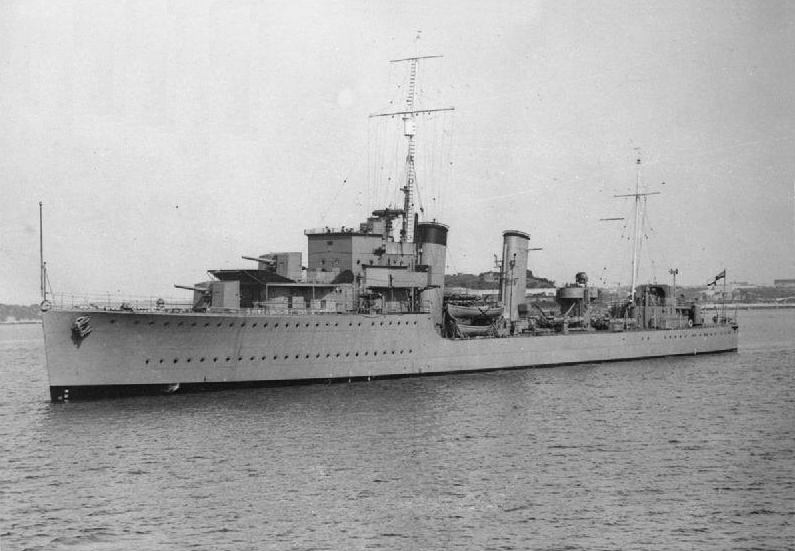
HMS Kempenfelt was ordered on 15 July 1930 from J. Samuel White (Cowes) under the 1929 Programme, laid down on 18 October 1930, launched on 30 September 1931, completed on 30 May 1932. As a flotilla leader, she had extra accomodations in and around the bridge for 15 long tons more, 30 more personnel of the flotilla captain staff.
British Service, 2nd Flotilla Leader
Kempenfelt was assigned to the 2nd Destroyer Flotilla, Home Fleet, and tested briefly a 5.1-inch (130 mm) gun on ‘B’ mount, until replaced by her 4.7-in gun. She was based at Rosyth in 1932, but visited the Mediterranean in January-March 1933 and then back home. She had a refit at Devonport until January 1934 and took part in the Home Fleet tour of the West Indies until March. She visited Scandinavia until the end of the year and toook part in King George V’s Silver Jubilee Fleet Review at Spithead (16 July 1935). She was sent in Red Sea with the 2nd Flotilla to monitor Italian warship movements (Abyssinian crisi) until April 1936. After a refit at Devonport until June she returned south for monitoring the Spanish coast during the Civil War from late 1936, also evacuating British nationals in various ports.
In December she was refitted at Devonport until 10 April 1937 and returned to Spanish waters. On 6 March with HMS Boreas she rescued survivors from the cruiser Baleares, sunk by Republican destroyers at the Battle of Cape Palos. Refitted at Chatham in May–June 1938 sje visited Scandinavia and joined the Portsmouth Local Flotilla until September 1939.
Canadian service
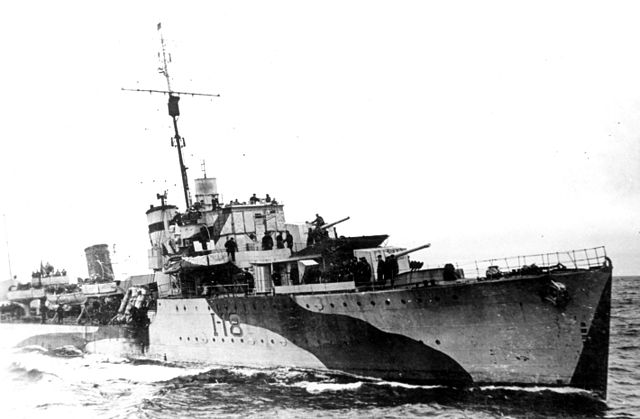
She was transferred to the 18th Destroyer Flotilla at the Isle of Portland, escorting shipping and conducted anti-submarine patrols until her prewar purchase by the Canadian government was not acted upon at first to allow the Royal Navy to compensate for her loss by having enough auxiliary ASW ships. However when it was time to do so she was under repairs after a collision. She was officially handed over on 19 October and recommissioned as HMCS Assiniboine. She sailed with her Canadian crew to Halifax on 17 November. There she was midified for RCN need with a modern ASDIC and steam heating. She was sent to the Caribbean in exchange for HMCS Saguenay, Kingston (Jamaica) on 8 December for a hotter start. She stayed for some time at the North America and West Indies Station, capturing the German blockade runner MV Hannover between Hispaniola and Puerto Rico on 8/9 March 1940.
She was previous captured by the light cruiser HMS Dunedin, but the crew disabled their steering and managed to set her on fire. The destroyer took her under tow to prevent out of the neutral Dominican Republic waters, while the cruiser used its pumps to put the fire down, then both ships swapped roles until it was safe to board the ship, by Dunedin’s boarding party. Assiniboine returned to Halifax on 31 March for a refit and afterwards started escorted local convoys until 15 January 1941.
She was transferred to Greenock, assigned to the 10th Escort Group, Mid-Ocean Escort Force, rescuing survivors from SS Anchises (28 February) but damaged in a collision with MV Lairdswood on 5 April, repaired until 22 May, transferred to St. John in Newfoundland from June to reinforce escort forces. In August with Restigouche and HMS Ripley (a former 4 piper), she escorted HMS Prince of Wales to Placentia Bay for the first meeting between PM Winston Churchill and President Franklin Roosevelt.
Epic Duel with U-210 (6 Aug. 1942)
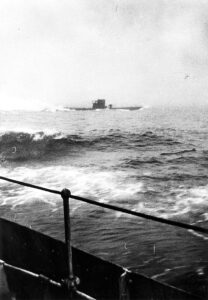 She escorted Convoy SC 94 in Escort Group C1, when her Type 286 radar spotted U-210 in heavy fog on 6 August 1942. She closed and spotted the the U-Boat twice, furing but losing her in the fog. Then she spotted her across her bow from just 50 yards (46 m), both opened fire at each others. Her 4.7-inch were too high in elevation to ht her, but she put to good use her Vickers quad .50-machine guns to cripple her deck and conning tower and prevent them using the 88-mm (3.5 in) deck gun. They however manned the 2 cm FLAK 38 which punctured Assiniboine’s plating and set her fuel tanks on deck afire. She lost ‘A’ gun as well, Ordinary Seaman Kenneth “Wiley” Watson being KiA. The captain was close enough to ram U-210 and when far enough her rear 4.7-inch barked and destroyed U-210’s bconning tower, killing the entire staff while the rest of the U-Boat was savaged by .50-caliber rounds, killing the 2 cm FLAK operator as later reported.
She escorted Convoy SC 94 in Escort Group C1, when her Type 286 radar spotted U-210 in heavy fog on 6 August 1942. She closed and spotted the the U-Boat twice, furing but losing her in the fog. Then she spotted her across her bow from just 50 yards (46 m), both opened fire at each others. Her 4.7-inch were too high in elevation to ht her, but she put to good use her Vickers quad .50-machine guns to cripple her deck and conning tower and prevent them using the 88-mm (3.5 in) deck gun. They however manned the 2 cm FLAK 38 which punctured Assiniboine’s plating and set her fuel tanks on deck afire. She lost ‘A’ gun as well, Ordinary Seaman Kenneth “Wiley” Watson being KiA. The captain was close enough to ram U-210 and when far enough her rear 4.7-inch barked and destroyed U-210’s bconning tower, killing the entire staff while the rest of the U-Boat was savaged by .50-caliber rounds, killing the 2 cm FLAK operator as later reported.
Wounded but still alive, Lt. Sorber still in the sub, ordered a crash dive, but he had to keep a straight course and Assiniboine, hard rudder, made a U-turn and made a second ramming attack. She hit her hard abaft the conning tower whilst diving, the concussion knocked down her electric motors and damaged her propellers, fracturing the pressure hull. Sorber seeing no point in divng now order to blow the ballast and abandon ship. The destroyer made a third ramming attack just as she resurfaced, while dropping a pattern of depth charges and peppering her with 4.7-inch shells for good measure. She sank but not before some escape via the two hatches, rescued by Assiniboine and the corvette HMS Dianthus, to report their point of view of the event. Sorber went down with the U-boat.
Later career 1942-45
After the action, engineers were sent to inspect the hull below the forecastle and saw a great del of leakages below the waterline. But her bulkhead hold strong and she needed back home two months of repairs at Halifax. She was next assigned to Escort Group C3 on 20 December. When en rout for Londonderry, she picked up a contact and dropped a shallow pattern of depth charges, but this badly damaged her stern on 2 March 1943. She was repaired at Liverpool (7 March-13 July) beofre being assigned to Escort Group C1. By April 1944 she was refitted at Shelburne, Nova Scotia. In July, she was assigned to the Western Approaches Command and in August joined the 12th Support Group. They spotted and engaged three German minesweepers on 12 August. Assiniboine will stay in British waters until the end of the war, being damaged in a collision with SS Empire Bond on 14 February 1945 and repaired until late March. Back home in June she became a repatriation transport before a boiler room fire on 4 July put her in reserve. Paid off on 8 August she was sold to breakers in Baltimore, but while towed her, she ran aground near East Point on Prince Edward Island and left to rust until the remains were BU in 1952. Due to her ramming attacks and numerous collisions, she was nicknamed “Bones” by her crew.
⚙ specifications |
|
| Displacement | 1,390 long tons (1,412 t) standard, 1,900 long tons (1,932 t) deep load |
| Propulsion | 2 shafts Parsons GS Turbines, 3× Yarrow 3-drum boilers 36,000 shp (27,000 kW) |
| Range | 5,500 nmi (10,200 km; 6,300 mi) at 15 knots (28 km/h; 17 mph) |
| Armament | 4× QF 4.7-inch Mk IX, 1× QF 3-inch AA, 2× QF 2-pdr pompom, 2×4 21-in TTs, DCs |
 D class leader HMS Duncan (D99)
D class leader HMS Duncan (D99)
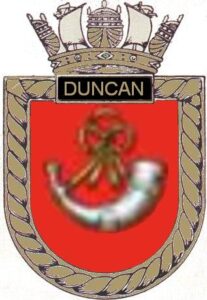 Duncan was ordered under the 1930 Naval Estimates on 2 February 1931, from Portsmouth Dockyard, laid down on 25 September 1931, launched on 7 July 1932, commissioned on 31 March 1933. As a flotilla leader she had extra accomodation which totalled 25 long tons more for 30 extra personnel, Captain (D) flotilla staff. She led the 1st Destroyer Flotilla in the Mediterranean, sailing in the Persian Gulf and Red Sea in September–November 1933. After refit at Portsmouth she led her squadron to the China Station, entering Hong Kong on 3 January 1935. She spent her time here “showing the flag” in the Far East, Japan, Philippines, the Dutch East Indies, Singapore, Thailand and Malaya. She had another refit between 14 December 1936 and 4 January 1937 but was damaged when testing refuelling at sea. She was in Shanghai as the Japanese invasion commenced in 1937, evacuating British civilians to Woosung with HMS Falmouth. On 28 October 1938 she was rammed by the Greek steamer Pipina while anchored at Foo Chow, repaired and overhauled at Hong Kong (31 October-14 January 1939). Then she was hit by a high-speed target at Wei Hai Wei in July 1939.
Duncan was ordered under the 1930 Naval Estimates on 2 February 1931, from Portsmouth Dockyard, laid down on 25 September 1931, launched on 7 July 1932, commissioned on 31 March 1933. As a flotilla leader she had extra accomodation which totalled 25 long tons more for 30 extra personnel, Captain (D) flotilla staff. She led the 1st Destroyer Flotilla in the Mediterranean, sailing in the Persian Gulf and Red Sea in September–November 1933. After refit at Portsmouth she led her squadron to the China Station, entering Hong Kong on 3 January 1935. She spent her time here “showing the flag” in the Far East, Japan, Philippines, the Dutch East Indies, Singapore, Thailand and Malaya. She had another refit between 14 December 1936 and 4 January 1937 but was damaged when testing refuelling at sea. She was in Shanghai as the Japanese invasion commenced in 1937, evacuating British civilians to Woosung with HMS Falmouth. On 28 October 1938 she was rammed by the Greek steamer Pipina while anchored at Foo Chow, repaired and overhauled at Hong Kong (31 October-14 January 1939). Then she was hit by a high-speed target at Wei Hai Wei in July 1939.
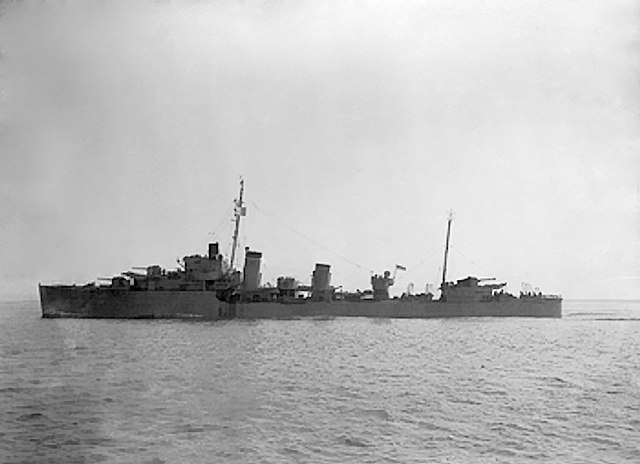
Duncan, Diana, Daring, and Dainty were transferred to the Mediterranean Fleet and made it into Alexandria on 30 September but in poor condition. After refit they started a tour of contraband control duties. In December with Duchess she escorted the battleship Barham back home via Gibraltar on 6 December. But on 10 December, Barham collided with Duchess while in the Mull of Kintyre in heavy fog, sinking her with 124 onnboard. Duncan then was assigned to the 3rd Destroyer Flotilla, Home Fleet on 12 December.
She had a collision with a merchant vessel on 17 January in Convoy ON18, creating 20-ft gash in her side. Flooding was contained and she taken under tow. She had temporary repairs at Invergordon, and towed to Grangemouth for full repairs until 22 July complete with post-refit trials. Back to Scapa Flow and the 3rd Destroyer Flotilla, then 13th Destroyer Flotilla at Gibraltar in October she escorted HMS Ark Royal, Barham, Berwick, Glasgow and Sheffield to Gibraltar creating Force H. She also followed Ark Royal during Operation Coat, and HMS Argus when flying off Hawker Hurricane fighters to Malta in Operation White. She escorted Force F to Malta also in Operation Collar in November. She was nearby during the Battle of Cape Spartivento in late November, escorting the convoy away from the Italians.
On 1 January 1941, she led the 13th Destroyer Flotilla intercepting a Vichy French convoy near Mellila, seizing all four merchant ships. Next she took part in Operation Excess convoy to Piraeus and Alexandria. She took part in Operation Grog in early February, escorting Force H shelling Genoa. She escorted the battlecruiser Repulse and HMS Furious from Gibraltar to West Africa in March and remaining in Freetown, escorting local convoys in West African waters until Jul. Recalled in the Mediterranean she escorted the convoy of Operation Substance from Gibraltar to Malta in July. She returned to the 13th Destroyer in Gibraltar and escorted Force H for Operation Halberd late September.
In October she escorted Convoy HG 75 from Gibraltar to Liverpool. Arriving on the 16th she had a refit at the Sheerness Dockyard until 23 January 1942, joining then the 13th Destroyer Flotilla at Gibraltar. In late February and March, she escorted HMS Eagle and Argus to Malta. In April, HMS Duncan was transferred to the 22nd Destroyer Flotilla, Eastern Fleet for Operation Ironclad, the invasion of Vichy-French Diego Suarez. She stayed for four months of operations in the Indian Ocean until back home for a refit. There, the admiralty wanted to convert her as an escort destroyer. She sailed back via Good hope escorting HMS Royal Sovereign. In Greenock on 16 November, her conversion started at Tilbury from 24 November.
Details: ‘A’ mount replace by Hedgehog, director-control tower/rangefinder removed for a Type 271 target indication radar, two 2-pdr AA between funnels exchanged for two Oerlikon 20 mm AA guns installed and two more on the searchlight platform. ‘Y’ removed to spare weight, extra depth charge stowage: 98 depth charges.
In March 1943 she carried out her sea trials to Tobermory and in April joined Escort Group B-7 as the Senior Officer’s ship (Commander Peter Gretton). She escorted Convoy ONS 5 in early May and this was a major battle, seeing the destruction of six U-boats, 13 ships lost. Duncan withdrawn for lack of fuel. Next she escorted Convoy SC 130: Three U-boats destroyed, no loss in the convoy.Duties in the North Atlantic went on until October 1943 and on the 16th she rescued 15 survivors from U-470 surfaced and damaged by a Consolidated B-24 Liberator. During the battle for Convoy ON 207 on 23 October she teamed with HMS Vidette and an FAA Liberator of No. 224 Squadron to corner and sink U-274. On 29 October, she co-claimed U-282 with Vidette and Sunflower when protecting Convoy ON 208.
Inspected, she was found in poor shape and an extensive refit started on 12 November 1943 until 17 May 1944 at North Woolwich at london Harland and Wolff yard. She then joined the 14th Escort Group for independent ASW patrols in the Western Approaches. She also was called to escort passing by convoys, until April 1945, assigned to the Greenock Coastal Escort Pool. At the end of her rope she was placed in reserve on 13 May, transferred to Barrow on 9 June, on disposal on 8 July, turned over to BISCO for scrapping, completed in 1949.
⚙ HMS Duncan specifications |
|
| Displacement | 1,400 long tons (1,400 t) |
| Propulsion | 2 shafts Parsons GS turbines, 3 × Admiralty 3-drum boilers, 36,000 shp. |
| Range | 5,870 nmi (10,870 km; 6,760 mi) at 15 knots (28 km/h; 17 mph) |
| Armament | Same but 20 depth charges, 1 rail and 2 throwers |
| Sensors | ASDIC, See notes |
| Crew | 175 |
 HMS Comet (H00)
HMS Comet (H00)  HMCS Restigouche
HMCS Restigouche
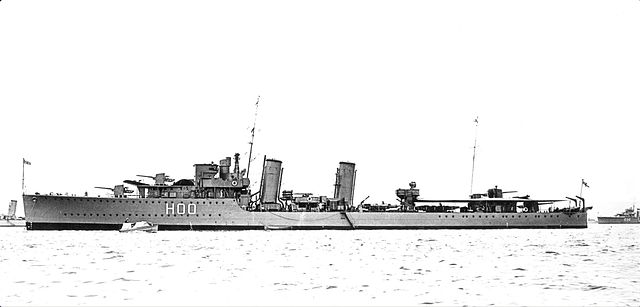
HMS Comet was laid down at HM Dockyard, Portsmouth on 12 September 1930, launched on 30 September 1931 and completed 2 June 1932. She served with the 2nd Destroyer Flotilla, Home Fleet in June. On 21 July, she was damaged in a collision with HMS Crescent at Chatham, repaired until 20 August and refitted later the next year from 20 July to 3 September 1934. With the Abyssinian crisis she was sent there in August 1935, patrolling the Red Sea with the 2nd Flotilla, monitoring the Italian Navy until March 1936.
Back home April 1936. She was refitted at Sheerness between 23 April and 29 June. In July she patrolled the Spanish coast and Bay of Biscay, intercepting contraband shipping and protect British flagged shipping. On 9 August she assisted the yacht Blue Shadow off Gijon, shelled by the Nationalist cruiser Almirante Cervera. She was reserve in late 1936 when discussions for a transfer to the Royal Canadian Navy were held. Two other sisters were chosen. She was sent in the Mediterranean as plane guard for HMS Glorious on 29 December.
In April 1937 she was back home with Glorious and on 20 May was at the Spithead Coronation Review before a refit at Portsmouth until 18 June and back as plane guard for Glorious, Mediterranean. She had her last peacetime refit at Chatham on 26 May 1938, brought to Canadian specs, notably the Type 124 ASDIC.
As HMCS Restigouche she had also a shortened aft funnel, 12-pdr AA replacing “B” torpedo mount, ‘Y’ gun absent and additional depth charge storage, central heating.
Commissioned on 11 June she was not ready before 20 August, transferred to the Canadian Pacific Coast, Esquimalt, arriving on 7 November 1938. She was then sent to Halifax on 15 November to guard local convoys, notably the one carrying the 1st Canadian Infantry Division to the UK on 10 December. She was in Plymouth on 31 May 1940 for extra modifications. On 9 June she sailed to Le Havre, France to evacuate British troops, notably from Saint-Valery-en-Caux, 40 miles (64 km) NE from Le Havre on 11 June. Without orders she refuse to embark the 51st Infantry Division and when recovering her landing party she was attacked by a German artillery battery, returned fire, no hit. Back home she escorted several troop convoys from Canada, Australia and New Zealand in June. On 23 June, she escorted the ocean liner SS Arandora Star to St. Jean de Luz, French southern coast, to evacuate Polish troops, British refugees as part of Operation Aerial. On 25 June 1940 Restigouche, HMCS Fraser and HMS Calcutta were returning from St. Jean de Luz when Fraser was rammed by Calcutta in the Gironde estuary, at night. Fraser was cut in half but did not sink immediately. 47 went down the rest were rescued as well as most of the evacuees by Restigouche. Her still floating rear portion could not be towed and was sunk by Restigouche.
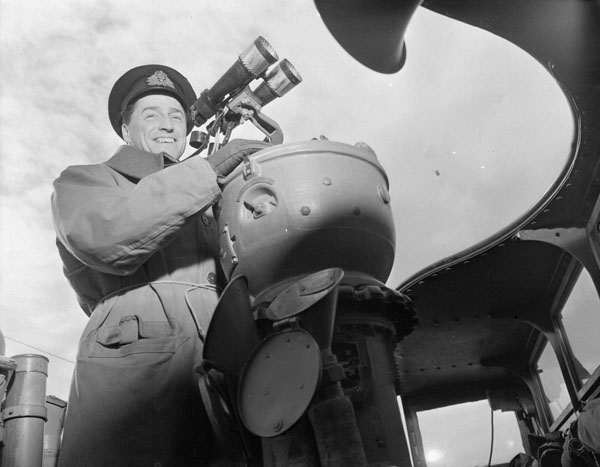
Lieutenant-Commander Desmond W. Piers, Commanding Officer, on the bridge of the destroyer HMCS Restigouche, which is escorting convoy SC-107 at sea, 21 April 1944
Restigouche was transferred to the Western Approaches Command and stuck to convoy escort duties, from Halifax by late August (refit until October) in local escort duties. From January 1941 she was reassigned in the UK to the Western Approaches Command. She then escorted local convoys off St. John’s, Newfoundland in May. While escorting Prince of Wales at Placentia Bay on 8 August, she damaged her propellers when grounding, repaired until October. Just out, she was badly damaged by a storm while joining Convoy ON-44 on 12 December. She stayed in Greenock until 9 March 1942, with mods sone, director-control tower/rangefinder removed, Type 271 target indication radar installed and later ‘A’ Hedgehog mortar installed, Oerlikon guns replacing her two quad .50-Vickers, two more, removal of her 12-pdr AA gun, Type 286 radar installed and two QF 6 pounder Hotchkiss guns on the bridge and ‘Y’ gun removed for more depth charge to 60.
She was assigned to the Mid-Ocean Escort Force and took part in several convoys. In April 1943 she joined Escort Group C4. On 10 April she rescued 23 survivors from the Dutch cargo ship Blitar. August-December refit done, she returned with C4 until, then 12th Escort Group by early 1944, Western Approaches.
In June–July 1944, she patrolled the English Channel and Bay of Biscay. On the night of 5–6 July, her Escort Group sank three small German patrol boats off Brest. On 12 August she engaged three minesweepers. She was back in Canada for a last, long refit and trials in Bermuda, back in Halifax on 14 February 1945, local convoys until May, and repatriation ship from Newfoundland to mainland Canada. She was paid off on 5 October, sold for scrap in 1946.
 HMS Crusader (H60)
HMS Crusader (H60) HMCS Ottawa
HMCS Ottawa
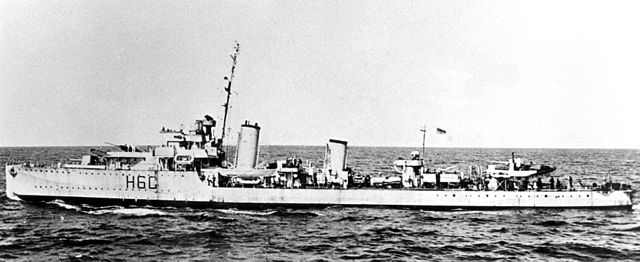
HMS Crusader was laid down on 12 September 1932, launched 2 June 1932 and completed on 2 May 1932. She was initially assigned to the 2nd Destroyer Flotilla, Home Fleet for four years. First refit at Portsmouth (30 July-4 September 1934). Abyssinian crisis watch August 1935 to March 1936, Red Sea. Portsmouth refit from 27 April to 30 May. Patrols, Spanish Civil War August–September 1936, evacuated British nationals, Bay of Biscay. Plane guard for HMS Courageous from January 1937 to March 1938. Refit 30 March-27 April 1937. Major refit Sheerness 28 April 1938 (Canadian specs), purchased by the Royal Canadian Navy, recommissioned on 15 June as HMCS Ottawa. Assigned to the Canadian Pacific Coast, Esquimalt, 7 November 1938. Sent to Halifax, Nova Scotia on 15 November 1939, escorted local convoys (notably 1st Canadian Infantry Division) but damaged in a collision with the tugboat Bansurf in April 1940, 2 months repairs.
On 27 August 1940, she sailed to Greenock, assigned to the 10th Escort Group, Western Approaches Command. On 24–26 September, she rescued survivors from SS Sulairia (sunk by U-43) and from SS Eurymedon (by U-29). She assisted Harvester in sinking the Comandante Faà di Bruno on 7 November. In mid-November she received alterations, notably the Type 286M short-range surface-search radar. On 23 November, she rescued 29 from SS Bussum (sunk by U-100).
Back to Canada in June 1941 she was assigned to the Newfoundland Escort Force, covering convoys in the Mid-Atlantic and the to the Escort Group C4 in May 1942. In September her captain refused to have her director-control tower/rangefinder removed for the Type 271 target indication radar. On 14 September she escorted Convoy ON 127, 500 nautical miles (930 km) east of St. John when torpedoed by U-91. Ten minutes later she was hit by a second torpedo and sank ten minutes later, 114 went down with her, including the captain, with 69 survivors. If her captain would have accepted the radar installation it’s well possible that she could have detected the U-Boat that sunk her, and perform a preventive attack.
 HMS Cygnet (H83)
HMS Cygnet (H83)  HMCS St. Laurent
HMCS St. Laurent
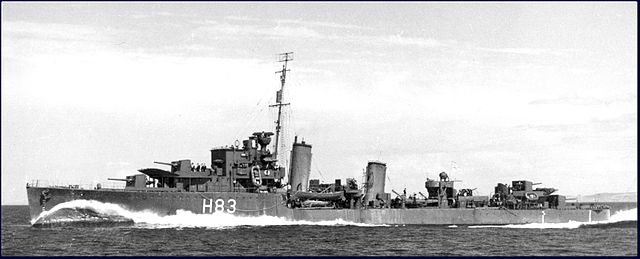
HMS Cygnet was ordered to Vickers Armstrongs, Barrow, laid down on 1 December 1930, launched on 29 September 1931 and completed on 15 April 1932. She was assigned to the 2nd Destroyer Flotilla, Home Fleet like her “C” sisters, led by Kempenfelt. Cygnet spent a long time in fixes and repairs in dockyard, Devonport before being deployed to the West Indies, Home Fleet in January-March 1934. TShe had a refit from 25 July to 31 August 193 and was dispatched with her unit in the Abyssinian Crisis, Red Sea from September 1935 to April 1936. After anothr refit at Devonport between 20 April and 18 June she saw patrols on the Spanish coast in the summer of 1936 and Bay of Biscay against contraband shipping, protecting British shipping.
Like HMS Crescent she was sold to Canada on 20 October 1936 for £400,000, refitted to Canadian standards, handed over on 1 February 1937 and recommissioned as HMCS St. Laurent on 17 February. She was assigned to Halifax in May, then Esquimalt in 1938 and back on 31 August 1939 to escort local convoys. She was in Plymouth on 31 May 1940 for modifications, and took part in Operation Dynamo, sailing to Le Havre and evacuated a small group of French soldiers on 11 June, but taken under fire by German artillery near Saint-Valery-en-Caux, not hit. Captain H.G. DeWolf, ordered to return fire and silenced them. She escorted troop convoys from Canada, Australia and New Zealand and took orders from the Western Approaches Command.
On 2 July while escorting HMS Nelson, St. Laurent was sent to assist SS Arandora Star, torpedoed by U-47, some 125 nautical miles NE of Malin Head in Ireland. After 4.5 hours of steaming hard, she still rescued 857 survivors, including axis POWs. Latr with the sloop HMS Sandwich, she badly damaged the German submarine U-52 in the battle for Convoy HX 60 on 4 August. On 2 December she rescued men from MAC HMS Forfar, torpedoed and sunk by U-99 and the oil tanker Conch.
She was refitted at Halifax from 3 March to 11 July 1941 and joined the 14th Escort Group for the Mid-Atlantic leg. With Convoy ON 33 in November she was badly damaged by a gale forced back to Halifax for repairs. Back to Mid-Ocean Escort Force until March 1943 she had another refit at Halifax in April–August 1942 and by December 1942, she received a radar and high-frequency direction finding system, assigned to Escort Group C1 for Convoy ON 154 in December 1942. On 27 December 1942 north of the Azores she spotted and attacked a surfaced U-boat and ended with a depth charge attack when she crash-dived after probably gun hits. She made several passes until seeing oil on the surface, later credited U-356.
Refitted in Dartmouth (17 August-December 1943) she returned to her convoy duties and on 10 March 1944, sank U-845 with HMS Forester, HMCS Owen Sound and HMCS Swansea. In May 1944 she was transferred to the 11th Escort Group for Operation Overlord, the landings in Normandy. On 6 June 1944 she sailed with HMCS Chaudière, Gatineau, Kootenay and Ottawa in the English Channel, north passage, preventing U-boat to try and get through. Next she was sent in the Bay of Biscay for ASW operations against U-Boats from Bordeaux. On 8 August she was attacked but missed by a Dornier 217 with glide bombs. On the 13th with Ottawa rescued survivors from U-270, sunk with depth charges (Sunderland). In October 1944 she returned to Canada for a refit at Shelburne until 20 March 1945. In April 1945 she was attached to the Halifax Escort Force and from 6 May, as troop transport until paid off on 10 October 1945, sold for scrap 1947.
 HMS Crescent
HMS Crescent  HMCS Fraser
HMCS Fraser
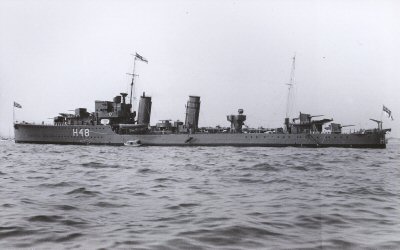 HMS Crescent was, laid down 1 December 1930, launched on 15 April 1932 and completed on 1 April 1934. She was assigned to the 2nd Destroyer Flotilla, Home Fleet. But she collided with HMS Comet at Chatham on 21 July, under repair until 27 August, followed by a refit at Chatham 30 March-6 May 1933, and join here unit in the West Indies January-March 1934, then new refit at Chatham 27 July-3 September and detached for the Abyssinian Crisis until April 1936, refitted at Sheerness (23 April-13 June), placed in reserve. She was was sold to Canada on 20 October 1936 for £400,000, refitted to Canuck standards, raken over on 1 February 1937, renamed and recommissioned as HMCS Fraser on 17 February at Chathem and departing for the Canadian Pacific Coast, Esquimalt, arriving on 3 May 1937 but ordered back to the East Coast on 31 August 1939.
HMS Crescent was, laid down 1 December 1930, launched on 15 April 1932 and completed on 1 April 1934. She was assigned to the 2nd Destroyer Flotilla, Home Fleet. But she collided with HMS Comet at Chatham on 21 July, under repair until 27 August, followed by a refit at Chatham 30 March-6 May 1933, and join here unit in the West Indies January-March 1934, then new refit at Chatham 27 July-3 September and detached for the Abyssinian Crisis until April 1936, refitted at Sheerness (23 April-13 June), placed in reserve. She was was sold to Canada on 20 October 1936 for £400,000, refitted to Canuck standards, raken over on 1 February 1937, renamed and recommissioned as HMCS Fraser on 17 February at Chathem and departing for the Canadian Pacific Coast, Esquimalt, arriving on 3 May 1937 but ordered back to the East Coast on 31 August 1939.
The war caught her via Panama Canal. She arrived at Halifax on 15 September and was used as local escort and then the North America and West Indies Station, then conveying the 1st Canadian Infantry Division to Britain by mid-December. In March 1940 she was part of the “Jamaica Force”. Then Western Approaches in May, on the 26 she departed, arrived at Plymouth on 3 June and taking part in Operation Dynamo. She was also modified for ASW escort like the others.
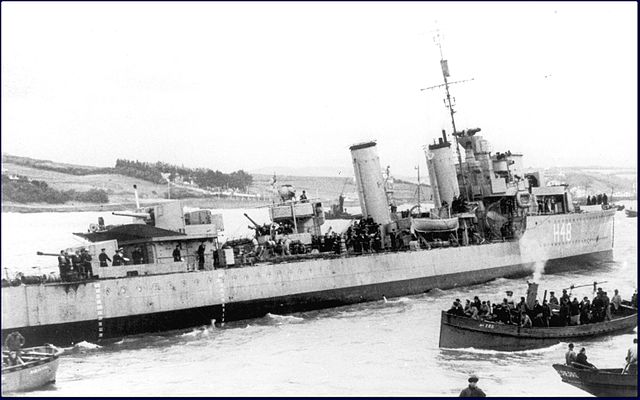
On 25 June 1940 she joined HMCS Restigouche and Calcutta to St. Jean de Luz, rescuing refugees trapped by the German Army in Operation Aerial when Fraser was rammed by Calcutta in the Gironde estuary. She lost her bow, down to the bridge, cut in two, sinking rapidly with all hands but 45, rescued by Restigouche and other vessels. Many survivors were transferred to HMCS Margaree, lost when she sank on 22 October 1940 after a collision with MV Port Fairy… Fate could be cruel.
 HMS Dainty (H53)
HMS Dainty (H53)
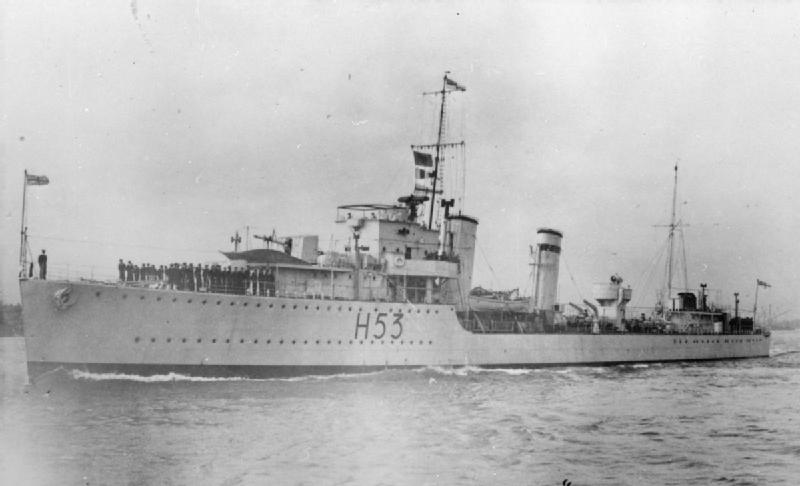
HMS Dainty was laid down at Fairfield, Govan on 20 April 1931, launched on 3 May 1932, completed on 22 December 1932. She joined the 1st Destroyer Flotilla, Mediterranean and sailed to the Persian Gulf and Red Sea in October–November 1933. Refitted at Portsmouth (3 September-23 October) she was transferred to the China Station, 8th (later 21st) Destroyer Flotilla from January 1935. Back to the Mediterranean Fleet, Red Sea until June 1936, Abyssinian Crisis. Refitted Hong Kong (21 September-15 October), anti-piracy patrols. Visited Sarawak, Singapore and the Philippines until March 1938. Transferred to the Mediterranean Fleet via Alexandria with Duncan on 30 September 1939.
Refit Malta from 8–30 December, transferred to the 2nd Destroyer Division in Freetown (Sierra Leone) hunting for German commerce raiders, South Atlantic. Refit Malta (21 April-2 June 1940), 10th Destroyer Flotilla. 12 June, rescued 400 survivors from HMS Calypso sunk off Crete. Escorted the French battleship Lorraine and three British cruisers to the raid on Bardia, 20/21 June. On 27 June, Dainty, Defender and Decoy, Ilex and HMAS Voyager attacked the Italian submarine Generale Liuzzi, badly damaged, scuttled. Dainty and Ilex attacked Uebi Scebeli and Salpa, first sank and captured important encryption material. She co-claimed Argonauta on 29 June off Tobruk. She took part in the Battle of Calabria on 9 July as escort for Force C, engaged Italian destroyers, no damage. With Defender, Diamond, and HMAS Stuart, cruisers Capetown and Liverpool she escorted Convoy AN.2 from Egypt to the Aegean Sea, late July. On 29 August with Diamond, Jervis, Juno she escorted the Auxiliary tanker Plumleaf and two merchant ships to Malta for relief. Dainty and Ilex escorted Sydney for the raid at Scarpanto on 4 September.
Later with three Australian destroyers and two British Dido class cruisers she escorted a convoy to Suda Bay, Crete, then Malta in November. Next month she captured two schooners off Bardia. In January 1941, she escorted Force A for Operation Excess and towed the disabled tanker Desmoulea to Suda Bay on 31 January.
In the late afternoon, 24 February 1941 she left Tobruk on patrol with Hasty when attacked by 13 Junkers Ju 88 bombers of III./Lehrgeschwader 1. Dainty dodged near hits but was was hit by a 1,000 lb (450 kg) bomb, passing through the captain’s cabin, detonating in the fuel tanks. The fire spread to her after magazine and it exploded. She was cut in two and sank with 16 killed and 18 wounded, but most of the crew was rescued by Hasty.
 HMS Daring (H16)
HMS Daring (H16)
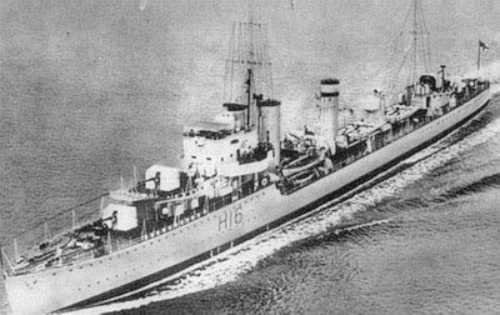
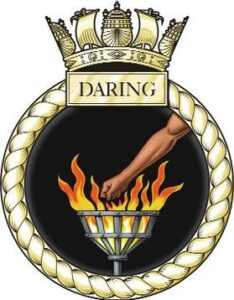 HMS Daring was laid down at Thornycroft, Woolston on 18 June 1931, launched 7 April 1932, completed on 25 November 1932. She joined the 1st Destroyer Flotilla, Mediterranean. Lord Louis Mountbatten was captain on 29 April 1934. She was refitted at Sheerness (3 September – 24 October) and served on the China Station. From December 1934 she served with 8th Destroyer Flotilla and was at Singapore, when Lord Mountbatten was transferred to command HMS Wishart, replaced by Geoffrey Barnard. With Duncan, Diana, and Dainty she was transferred to the Mediterranean, but kept patrolling in the Red Sea until November 1939. Refit Malta (25 November-20 December). She escorted SS Dunnottar Castle to Belfast by early 1940. Refit Portsmouth until 25 January. Assigned to the 3rd Destroyer Flotilla in Scapa Flow, 10 February. Escorted Convoy HN12 from Norway but torpedoed on 18 February by U-23 (Otto Kretschmer). She capsized and sank after loosing her stern, probably the DCs detonated. 157 went down with her. One officer and three ratings were rescued by Inglefield the following days. Another by Ilex and the sub HMS Thistle.
HMS Daring was laid down at Thornycroft, Woolston on 18 June 1931, launched 7 April 1932, completed on 25 November 1932. She joined the 1st Destroyer Flotilla, Mediterranean. Lord Louis Mountbatten was captain on 29 April 1934. She was refitted at Sheerness (3 September – 24 October) and served on the China Station. From December 1934 she served with 8th Destroyer Flotilla and was at Singapore, when Lord Mountbatten was transferred to command HMS Wishart, replaced by Geoffrey Barnard. With Duncan, Diana, and Dainty she was transferred to the Mediterranean, but kept patrolling in the Red Sea until November 1939. Refit Malta (25 November-20 December). She escorted SS Dunnottar Castle to Belfast by early 1940. Refit Portsmouth until 25 January. Assigned to the 3rd Destroyer Flotilla in Scapa Flow, 10 February. Escorted Convoy HN12 from Norway but torpedoed on 18 February by U-23 (Otto Kretschmer). She capsized and sank after loosing her stern, probably the DCs detonated. 157 went down with her. One officer and three ratings were rescued by Inglefield the following days. Another by Ilex and the sub HMS Thistle.
 HMS Decoy (H75)
HMS Decoy (H75)  HMCS Kootenay
HMCS Kootenay

HMS Decoy was laid down 25 June 1931, launched on 7 June 1932 and completed on 17 January 1933. She joined the 1st Destroyer Flotilla, same records as above. Refit Devonport Dockyard 3 September-20 October 1934, China Station 8th Destroyer Flotilla, returned to the Med for the Abyssinian Crisis and back to Hong Kong, refitted October, toured Southeast Asia in 1937. Recalled in August 1939.
Contraband control dutiesand in December extensive refit in Malta (corrosion problems, boiler feedwater pumps, funnels). January 1940, transferred to Freetown and 20th Destroyer Flotilla, convoys West African coast route. Mediterranean in May, 10th Destroyer Flotilla. With Defender, she escorted Convoy US-2 (ANZAC to the Middle East via the Red Sea). Took part in the raid on Bardia 20/21 June. 27 June 1940, sinking of Liuzzi off Crete. 29 June 1940 co-claimed Argonauta. Took part in Operation MA3, British convoys from Greece to Port Said and from Alexandria to Malta. Co-claimed Argonauta off Ras el Hilal in Libya (contested logs). Took part of the Battle of Calabria, hit by near-miss from Giulio Cesare.
Took part in Operation Hats, took part in the raid of Scarpanto 3/4 September. 6 November with Defender, Hasty, Havock, Hereward, Hero, Hyperion, Ilex, Janus, Jervis, Mohawk, and Nubian escorted force H on distant cover for Convoy MW3 to Malta and back Convoy ME3 (Operation MB8). In Alexandria, she was struck by a bomb, which went through on 13 November. Temporary repairs, sent to Malta for permanent repairs until 1 February 1941, more damage on 19 January. 25 February saw her in Operation Abstention with Hereward and Ladybird and she landed commandos on Kastelorizo and picked up survivors, repelled by the Italians.
She took part in Operation Demon evacuation from Greece in April, and troops from Crete to Egypt after Operation Merkur. On 22 May she evacuated Greek King George II and family and staff to Alexandria. Escorted convoys to Tobruk and on 25 November, HMS Barham when torpedoed by U-331. Damaged in a collision in December, repaired at Malta until 8 February 1942. Transferred to the Eastern Fleet, Indian Ocean, Force B and learned about the IJN carrier raid of March–April 1942 and loss of Hermes. Refit in September in Greenock from 29 October.
She was refitted at Palmers, Hebburn-on-Tyne from 3 November to 12 April 1943, modernized, rearmed and with new radars, but transferred to the Royal Canadian Navy on 1 March, recommissioned on 12 April as HMCS Kootenay, gifted to the Canadians on 15 June. She teamed with Escort Group C5 for convoy escort, North Atlantic. On 22 May 1943 she rescued 19 survivors from the Nor. tanker Sandanger (sunk by U-221). Refit from late October to December in Halifax and back to her group and then 11th Escort Group by May 1944 for Operation Overlord. Sent to the English Channel and Bay of Biscay. Kootenay, Ottawa and Statice sank U-678 south of Brighton on 7 July 1944. With Ottawa and Chaudière she sank U-621 in the off La Rochelle on 18 August and on the 20th U-984 west of Brest. She was refitted between 2 October 1944 and 27 February 1945 at Shelburne Dockyard and returned to the Channel in April and then used as troop transport between Newfoundland and Quebec City. Placed in reserve reserve at Sydney, Nova Scotia on 26 October, stricken sold for BU 1946.
 HMS Defender (H07)
HMS Defender (H07)

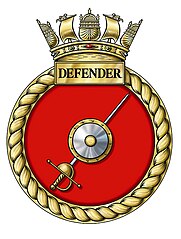 HMS Defender was laid down at Vickers Armstrongs on 22 June 1931, launched on 7 April 1932 and completed on 31 October 1932. Served with the 1st Destroyer Flotilla, Mediterranean, Persian Gulf-Red Sea, refitted at Devonport until 23 October 1934, then China Station, 8th Destroyer Flotilla Hong Kong from January 1935. Mediterranean, Abyssinian Crisis, East Africa. Refitted at Singapore until 26 January 1939, boilers retubed, superheaters repaired at Hong Kong until 14 March. Recalled to the Mediterranean Fleet, Alexandria from 19 September. Contraband control, sent to Gibraltar January 1940. Patrolled the Portuguese coast, transferred to Freetown in February, convoys, West African coast. Gibraltar in April escorting HMS Neptune on 23 April 1940. In May, joined the 10th Destroyer Flotilla, Mediterranean, escorted Convoy US-2 12-17 May. 27 June co-claimed Liuzzi, took part in the Battle of Calabria on 9 July, no damage. Escorted Convoy AN.2 late July.
HMS Defender was laid down at Vickers Armstrongs on 22 June 1931, launched on 7 April 1932 and completed on 31 October 1932. Served with the 1st Destroyer Flotilla, Mediterranean, Persian Gulf-Red Sea, refitted at Devonport until 23 October 1934, then China Station, 8th Destroyer Flotilla Hong Kong from January 1935. Mediterranean, Abyssinian Crisis, East Africa. Refitted at Singapore until 26 January 1939, boilers retubed, superheaters repaired at Hong Kong until 14 March. Recalled to the Mediterranean Fleet, Alexandria from 19 September. Contraband control, sent to Gibraltar January 1940. Patrolled the Portuguese coast, transferred to Freetown in February, convoys, West African coast. Gibraltar in April escorting HMS Neptune on 23 April 1940. In May, joined the 10th Destroyer Flotilla, Mediterranean, escorted Convoy US-2 12-17 May. 27 June co-claimed Liuzzi, took part in the Battle of Calabria on 9 July, no damage. Escorted Convoy AN.2 late July.
6 November, distant escort for Convoy MW3 and ME3 from Malta (Operation MB8). Took part in Operation Collar in late November with HMS Coventry and 4 destroyers. Sailed from Alaxandria to meet a convoy from Gibraltar to Malta on 26 November. Escorted HMS Ramillies, Berwick and Newcastle (Force D) t meet Force H coming from Gibraltar and the Battle of Cape Spartivento.
On 7 January 1941, Defender escorted Convoy MW.5 with Diamond and Calcutta from Alexandria to Malta (Operation Excess) and refitted there (4 February – 19 March) and was present at the Battle of Cape Matapan on 27–29 March. Next she was in Operation Demon, allied evacuation from Greece. On 27 April 1941 Defender, Hereward, Hero, HMS Phoebe protected Convoy GA.14 from Souda Bay to Alexandria and hempled recuing troops and crew from the sunken Dutch Costa Rica. She escorted Convoy GA.15 on 29–30 April to Alexandria, attacked by night by an Italian destroyer and two TBs in the Kaso Strait, rebuffed by escorts. Next she helped evacuating troops from Crete to Egypt after the German invadion on 22 May, Operation Merkur.
On 10 June, Defender and the 10th Destroyer Flotilla arrived off the Lebanese coast, reinforced RN forces for Operation Exporter, invasion of Vichy French Syria-Lebanon. Next she escorted convoys to and from Tobruk . On 29 June she assisted the badly damaged HMAS Waterhen off Tobruk, took Waterhen her in tow, but she sanka day later.
On 11 July 1941 with Vendetta she was attacked by a single Ju 88 from I./Lehrgeschwader 1, piloted by Gerhard Stamp before dawn, scorig a near-miss on Defender, detonating under her engine room. This broke her back, flooding the engine room (no casualties) and she was towed by Vendetta until she started to separate, so she was scuttled with torpedo and gunfire off Sidi Barrani after five hours.
 HMS Delight (H38)
HMS Delight (H38)
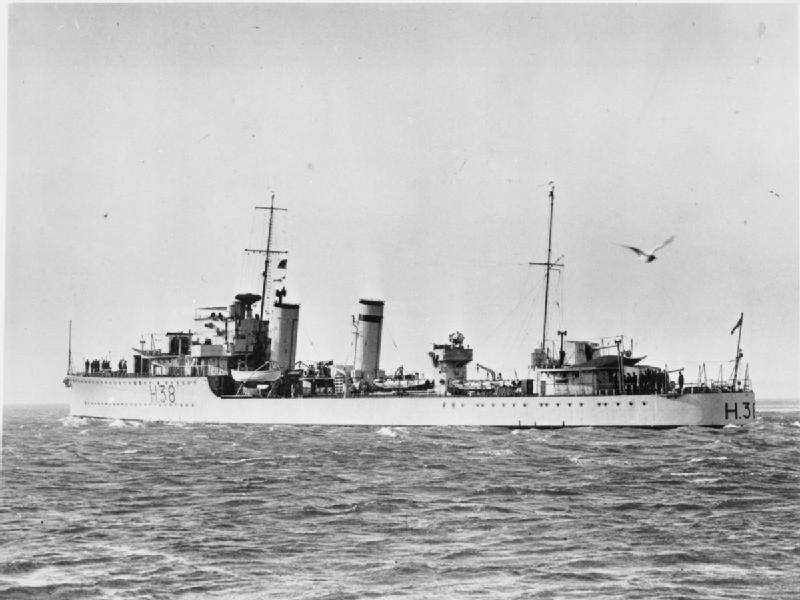
HMS Delight was laid down at Fairfield, Govan on 22 April 1931, launched on 2 June 1932 and commissoned on 31 January 1933. She helped with sea trials, Mark IX torpedo until 24 April 1933 and joined the 1st Destroyer Flotilla, Mediterranean. Same records here, Persian Gulf, China Station 8th DF from January 1935 then Med again from September to November 1935 (Abyssinian Crisis) and back. She returned in the Mediterranean on 19 September 1939 to Aden and Alexandria with three months of patrols, and sent to the Home Fleet in December, refitted until 27 January 1940 and joining the 3rd DF. She was damaged in heavy weather, 8 April repaired. She took part in the Norwegian Campaign escorting HMS Furious in April and on 1 May ferried troops to the light cruisers HMS Manchester and HMS Birmingham (18th CS) for the evacuation from Åndalsnes and supported Allied troops on 27–28 May marching on Bodø, then evacuated them. On 7–8 June, HMS Delight escorted another troop convoy of evacuation from narvik, Operation Alphabet.
She assisted the crippled AMC HMS Scotstoun (by U-25 on 13 June). She had her superheater tubes replaced at Rosyth (21 June-24 July). With the battle of Britain, the English Channel became a new battle ground until August and after departing Portland on 29 July, she was detected by a Freya radar at Cherbourg and intercepted by the Luftwaffe. At 19:25 no less than twelve Ju 87s belonging from III./Sturzkampfgeschwader 2 (Gruppenkommandeur Walter Enneccerus) fell on her 20 miles (32 km) off Portland Bill. She was hit by direct hit in the forecastle with a major fire and and explosion of A-B mount’s ammunitions. She sank much later, evacuating in goord orders but loosing six men KiA during the attack. She was located later under 62 metres (203 ft), now a protected place (Act 1986).
 HMS Diamond (H22)
HMS Diamond (H22)
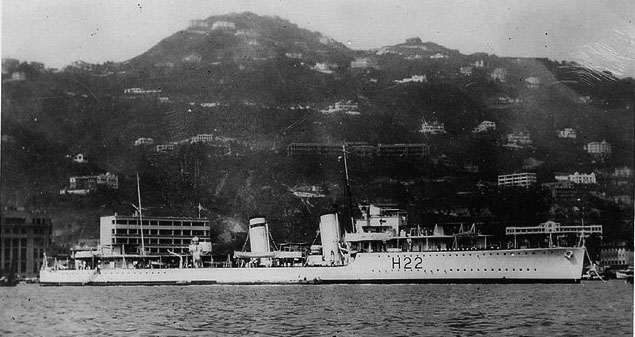
HMS Diamond was laid down at Vickers Armstrongs, Barrow on 29 September 1931, launched on 8 April 1932 and completed on 3 November 1932. She joined initially the 1st Destroyer Flotilla, Mediterranean, same as above. She was transferred back to the Med after a last refit at Singapore on 7 August 1939 and was in Malta on 19 December, transferred to the South Atlantic Station, leaving Malta on 8 January 1940 for Freetown and the 20th Destroyer Division. In April she was back in the Mediterranean joining Diamond and the 10th Destroyer Flotilla.
She was under air attacks on 11 and 17 June near Malta. Later with Dainty, Defender, and HMAS Stuart, Capetown and Liverpool escorting Convoy AN.2 to the Aegean Sea in late July. She shelled the airfield at Bomba, Libya on 23 August. She escorted four transports to Malta with Dainty, Jervis and Juno (Operation Hats) and escorted Convoy MB.8 in Operation Collar. She arrived at Malta on 26 November, joined Force D, met Force H from Gibraltar. She was not engaged directly in the Battle of Cape Spartivento. However in Operation Excess escorted Convoy MW.5 to Malta (January 1941). In mid-April she four freighters from Malta to Alexandria.
On the evening of 26 April, she headed in the Argolic Gulf with three light cruisers, three destroyers, escorting two troopships evacuating allied troops from Nauplia. HMS Calcutta and HMS Orion and HMS Hotspur, Isis with 2,500 troops at 03:00 with troop ships. However the Dutch ocean liner Slamat disobeyed the order to leave and continued to embark 500 troops before departing at 04:15, with the convoy sailing for Crete, but this was the start of Luftwaffe operations.
Near the mouth of the Argolic Gulf, nine Luftwaffe Ju 87 Stuka from Sturzkampfgeschwader 77 spotted and attacked them at 06:45 and hit Slamat. Calcutta ordered Diamond to assist Slamat and rescue survivors while the remainder would proceed to Souda Bay. At 08:15 she was still rescuing survivors. Meanwhile HMS Wryneck was detached to assist her, and Diamond fired a torpedo to sink the burning Slamat before departing. Diamond reported the almost full rescue at 09:25, proceeding to Souda Bay but at 10.25 signalled a request for aircraft cover and at 13:15 she was caught by a formation of Bf 109 fighters and Ju 88 bombers which sank her and Wryneck, launching their whaler and three Carley floats each, not enough by a long shot for everybody. The whaler was last spotted off Cape Maleas, towing two Carley floats and later Griffin rescued 50 from Wryneck and Diamond and some from Slamat. Henry Pridham-Wippell having no news sent HMS Griffin where Slamat had been lost, finding 14 more survivors in two Carley floats and 4 more in the morning. Survivors in Wryneck’s whaler reached Crete. Most escaped later on a caïque and reached Souda Bay.
 HMS Diana (H49)
HMS Diana (H49) HMCS Margaree
HMCS Margaree
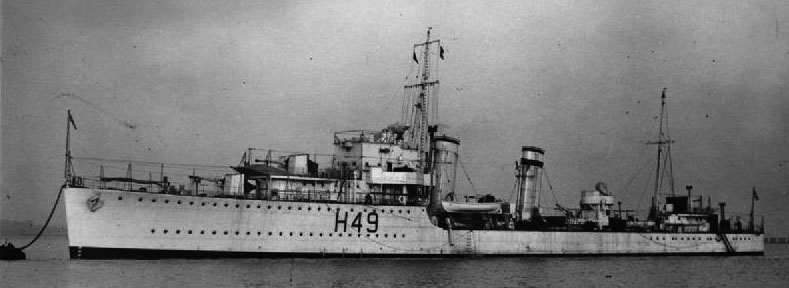
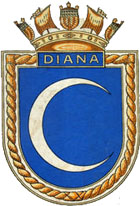 HMS Diana was laid down at Palmers, Jarrow on 12 June 1931, launched on 16 June 1932 and completed on 21 December 1932. She was assigned to the 1st Destroyer Flotilla, Mediterranean, was deployed on the Persian Gulf and Red Sea (September–November 1933), refitted at Sheerness (3 September-23 October 1934) was posted at the China Station returned only for the Abyssinian Crisis and was back to Hong Kong. In 1937 she investigated an unlit lighthouse near Amoy, previously attacked by pirates. She was recalled in August 1939 and with Duncan, Daring, and Dainty was in Malta by November and on contraband patrol until joining the Home Fleet’s 3rd Destroyer Flotilla by January 1940. On 15 February she escorted HMS Duncan to the forth from Invergordon for permanent repairs after a collision.
HMS Diana was laid down at Palmers, Jarrow on 12 June 1931, launched on 16 June 1932 and completed on 21 December 1932. She was assigned to the 1st Destroyer Flotilla, Mediterranean, was deployed on the Persian Gulf and Red Sea (September–November 1933), refitted at Sheerness (3 September-23 October 1934) was posted at the China Station returned only for the Abyssinian Crisis and was back to Hong Kong. In 1937 she investigated an unlit lighthouse near Amoy, previously attacked by pirates. She was recalled in August 1939 and with Duncan, Daring, and Dainty was in Malta by November and on contraband patrol until joining the Home Fleet’s 3rd Destroyer Flotilla by January 1940. On 15 February she escorted HMS Duncan to the forth from Invergordon for permanent repairs after a collision.
She took part in the Norwegian Campaign, escorting HMS Furious back to Scapa Flow on 25 April and screened in May the light cruisers HMS Manchester and HMS Birmingham covering evacuations from Åndalsnes. She escorted HMS Glorious and Furious flying RAF Gloster Gladiators to Bardufoss airfield on 21 May. Next she escorted HMS Ark Royal and Furious in Operation Alphabet, withdrawal from Norway.
She had a refit in London in July and transferred to the RCN, replacing HMCS Fraser, sunk in a collision on 25 June 1940 with HMS Calcutta. She was recommissioned as HMCS Margaree on 6 September 1940 and on 17 October, escorted Convoy OL8 to Canada, but she was sunk just five days later, cut in two when rammed by the freighter MV Port Fairy after midnight, 22 October. Of 176, only six officers and 28 ratings in the stern section (remaining afloat) survived, rescued by Port Fairy.
 HMS Duchess (H64)
HMS Duchess (H64)
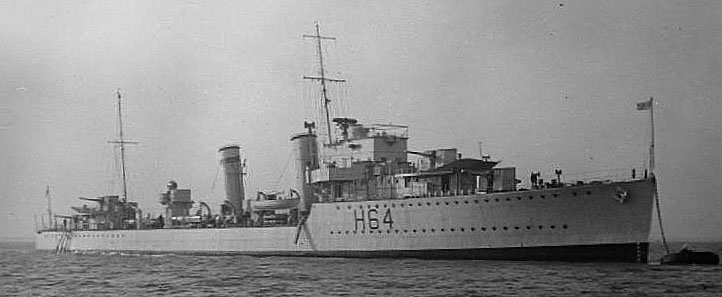
HMS Duchess was laid down on 12 June 1931, launched on 19 July 1932 at Palmers, completed on 27 January 1933. She was in the 1st Destroyer Flotilla and had the same career, see above. During a typhoon at Hong Kong on 2 September 1937, a merchant ship rammed her stern when dragging on her anchors and she was repaired until 14 October. She was recalled to the Med by late August 1939, transiting via Suez and Malta on 12 October, remaining in this theater for two months until her lsos. In December with HMS Delight, Duncan and Dainty, she escorted HMS Barham back to the UK, leaving Gibraltar on 6 December. Underay on 12 December, Barham collided with HMS Duchess off the Mull of Kintyre, in heavy fog. She capsized and her depth charges exploded. This blasted her entire aft section, killing 136 including her commanding officer (Lieutenant Commander Robert C. M. White) trapped in his sea cabin when his sliding door jammed.
Read More/Src
Books
Cocker, Maurice Destroyers of the Royal Navy, 1893-1981, 1983, Ian Allan
Conway’s All the World’s Fighting Ships, 1922-1946, Ed. Robert Gardiner, Naval Institute Press
M. J. Whitley Destroyers of World War II, An International Encyclopedia, Arms and Armour Press, 1988
Links
on navypedia.org/
dreadnoughtproject.org
en.wikipedia.org
uboat.net/ class
battleships-cruisers.co.uk/
naval-history.net/ Duncan.htm
Model Kits
None found (yet)


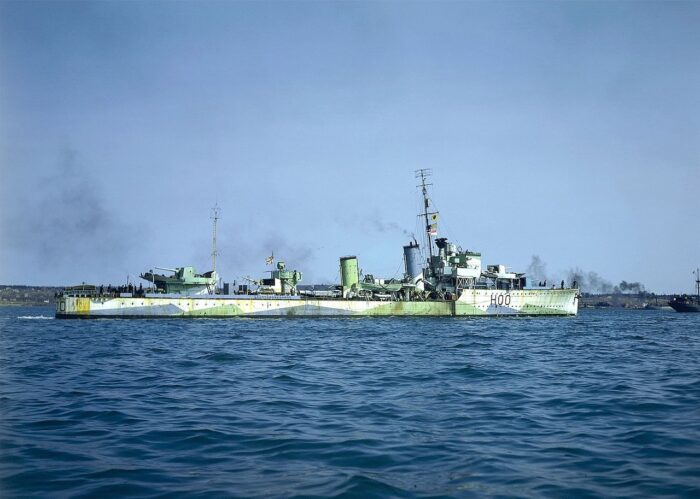
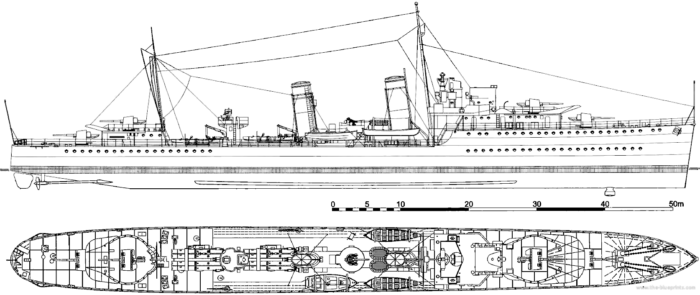
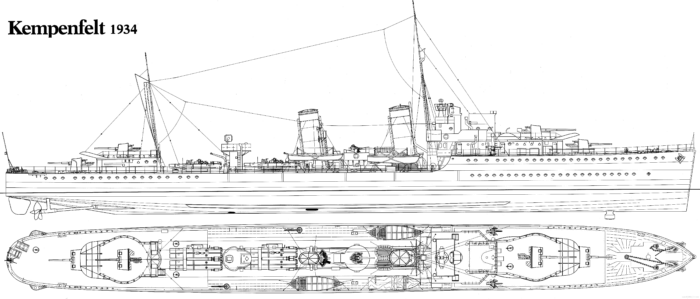
 Latest Facebook Entry -
Latest Facebook Entry -  X(Tweeter) Naval Encyclopedia's deck archive
X(Tweeter) Naval Encyclopedia's deck archive Instagram (@navalencyc)
Instagram (@navalencyc)





 French Navy
French Navy Royal Navy
Royal Navy Russian Navy
Russian Navy Armada Espanola
Armada Espanola Austrian Navy
Austrian Navy K.u.K. Kriegsmarine
K.u.K. Kriegsmarine Dansk Marine
Dansk Marine Nautiko Hellenon
Nautiko Hellenon Koninklije Marine 1870
Koninklije Marine 1870 Marinha do Brasil
Marinha do Brasil Osmanlı Donanması
Osmanlı Donanması Marina Do Peru
Marina Do Peru Marinha do Portugal
Marinha do Portugal Regia Marina 1870
Regia Marina 1870 Nihhon Kaigun 1870
Nihhon Kaigun 1870 Preußische Marine 1870
Preußische Marine 1870 Russkiy Flot 1870
Russkiy Flot 1870 Svenska marinen
Svenska marinen Søværnet
Søværnet Union Navy
Union Navy Confederate Navy
Confederate Navy Armada de Argentina
Armada de Argentina Imperial Chinese Navy
Imperial Chinese Navy Marinha do Portugal
Marinha do Portugal Mexico
Mexico Kaiserliche Marine
Kaiserliche Marine 1898 US Navy
1898 US Navy Sovietskiy Flot
Sovietskiy Flot Royal Canadian Navy
Royal Canadian Navy Royal Australian Navy
Royal Australian Navy RNZN Fleet
RNZN Fleet Chinese Navy 1937
Chinese Navy 1937 Kriegsmarine
Kriegsmarine Chilean Navy
Chilean Navy Danish Navy
Danish Navy Finnish Navy
Finnish Navy Hellenic Navy
Hellenic Navy Polish Navy
Polish Navy Romanian Navy
Romanian Navy Turkish Navy
Turkish Navy Royal Yugoslav Navy
Royal Yugoslav Navy Royal Thai Navy
Royal Thai Navy Minor Navies
Minor Navies Albania
Albania Austria
Austria Belgium
Belgium Columbia
Columbia Costa Rica
Costa Rica Cuba
Cuba Czechoslovakia
Czechoslovakia Dominican Republic
Dominican Republic Haiti
Haiti Hungary
Hungary Honduras
Honduras Estonia
Estonia Iceland
Iceland Eire
Eire Equador
Equador Iran
Iran Iraq
Iraq Latvia
Latvia Liberia
Liberia Lithuania
Lithuania Mandchukuo
Mandchukuo Morocco
Morocco Nicaragua
Nicaragua Persia
Persia San Salvador
San Salvador Sarawak
Sarawak Uruguay
Uruguay Venezuela
Venezuela Zanzibar
Zanzibar Warsaw Pact Navies
Warsaw Pact Navies Bulgaria
Bulgaria Hungary
Hungary

 Bundesmarine
Bundesmarine Dutch Navy
Dutch Navy Hellenic Navy
Hellenic Navy Marina Militare
Marina Militare Yugoslav Navy
Yugoslav Navy Chinese Navy
Chinese Navy Indian Navy
Indian Navy Indonesian Navy
Indonesian Navy JMSDF
JMSDF North Korean Navy
North Korean Navy Pakistani Navy
Pakistani Navy Philippines Navy
Philippines Navy ROKN
ROKN Rep. of Singapore Navy
Rep. of Singapore Navy Taiwanese Navy
Taiwanese Navy IDF Navy
IDF Navy Saudi Navy
Saudi Navy Royal New Zealand Navy
Royal New Zealand Navy Egyptian Navy
Egyptian Navy South African Navy
South African Navy






























 Ukrainian Navy
Ukrainian Navy dbodesign
dbodesign